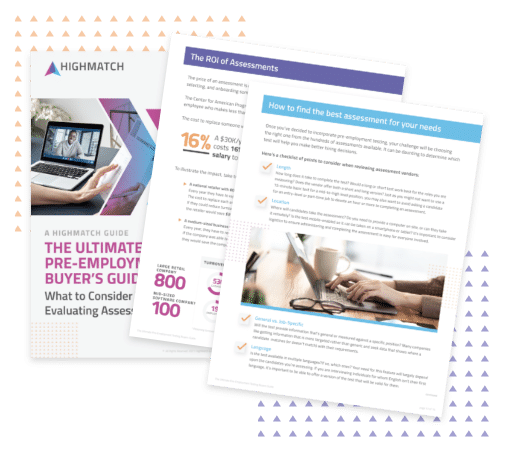HighMatch Guides
What is a pre-employment assessment?
Introduction
A pre-employment assessment, also called a pre-employment test, is used to gather objective data about job candidates. They inform decisions about whether or not a candidate can be successful in the role for which they’re applying.
There are different types of assessments such as aptitude tests, personality tests, skills tests, and physical ability tests. Review of biographical data and work samples are also types of pre-employment tests.
Incorporating pre-employment assessments into the hiring process is the most effective way
to gain a more thorough, accurate picture of a candidate’s strengths, challenges, and potential.
This guide is focused on web-based tests that utilize standardized questions to assess a person’s abilities, personality, and skills.
This guide will cover the following:
- How a pre-employment assessment works
- What do pre-employment assessments measure?
- Who uses pre-employment assessments?
- Are pre-employment assessments legal?
- What do candidates think about pre-employment assessments?
- Benefits of pre-employment assessments
- ROI of assessments
- Reliability of pre-employment assessments
- Validity of pre-employment assessments
- How to find the best assessment for your needs
- What to consider before implementing a pre-employment assessment?
- How to successfully implement a pre-employment assessment
How pre-employment assessments work
Pre-employment assessments work by measuring candidates against a predetermined set of criteria. This is done by evaluating the candidate’s responses to a set of standardized questions. The resulting assessment report shows each criteria and the candidate’s score for it, which represents how strongly they embody that criteria.
What do pre-employment assessments measure?
Pre-employment tests are used to measure a wide range of job-related traits and skills. Different types of assessments can help identify:
Personality
Personality traits describe how an individual relates to the world and affect how people naturally act or react in various situations. Commonly measured personality traits are extraversion, conscientiousness, openness to new situations, optimism, adaptability, stress tolerance, emotional stability, and initiative.
Aptitude
Aptitude or cognitive tests measure a candidate’s problem-solving skills or intelligence. Cognitive skills affect people’s ability to learn new things and process complex or higher level concepts. The goal of cognitive ability tests is to understand a person’s potential to solve job-related problems.
Skills
Skills are things that can be learned, and change over time, whereas personality and
aptitude are innate qualities that endure over a period of years, growing— if at all— only slowly. Frequently measured skills are typing, leadership, communication, and time management.
Job Fit
Job fit assessments compare a candidate’s traits and abilities with the traits and abilities required to succeed in a particular job. When the two are in alignment, the job fit score is high. When there is a misalignment between what the job requires and the traits a person possesses, job fit is low.
Who uses pre-employment assessments?
Pre-employment assessments are used extensively by businesses of all size and across a wide range of industries. According to the Talent Board’s recent Candidate Experience Research Report, 82% of companies are using some form of pre-employment assessment during the hiring process, with approximately 80% of Fortune 500 companies testing candidates pre-hire.
A 2017 study by Aberdeen found that 36% of Best-in-Class organizations were
more likely to use assessments in the pre-hire stage. The usage of assessments has steadily increased year after year.
Are pre-employment assessments legal?
Like all hiring selection tools, pre-employment assessments are subject to a series of legal standards. The Uniform Guidelines on Employee Selection Procedures (UGESP) are what inform the legal standards.
UGESP was adopted by the Equal Employment Opportunity Commission (EEOC) in 1978 for the purpose of enforcing Title VII of the Civil Rights Act of 1964.
The UGESP requires that organizations use reasonable efforts to prevent unfair discrimination in hiring, and explicitly recognize organizations’ legal right to use professionally-developed and well-validated pre-employment assessments for hiring.
Because assessments are designed to be bias-free and help ensure equitability, the use of valid assessments can actually improve the legal defensibility of hiring processes.
What do candidates think about pre-employment assessments?
As assessment usage has grown, candidates often expect to take an assessment as part of the interview process. Previously, candidates were wary of assessments and didn’t understand why they were being asked to take a test. That sentiment has changed as assessment usage has grown.
Now, candidates understand the value of the assessments, in placing the right person in the right job. Still, you are asking for the candidate’s time, energy, and focus, so keep these things in mind:
- Be transparent: explain why you’re asking candidates to take the assessment, how the assessment invitation will be delivered, and what feedback they can expect to receive
- Be respectful of their time: give candidates the option to take the assessment on their mobile device, and keep the assessment as brief as possible
- Keep things casual: ease candidate “test anxiety” by explaining that assessments are one piece of the puzzle. Assessments are meant to help both parties. Just as employers want to understand job fit, candidates want to know if they are a good fit for the role
Benefits of pre-employment assessments
Hiring new team members can be time-consuming, costly, and stressful. Candidates with impressive resumes and who interviewed well may end up falling short when it comes to performance because of mismatches between their traits and the job requirements.
To mitigate the risk of making hiring mistakes, many employers utilize pre-employment tests in their selection practices. Pre-employment testing is a systematic and efficient approach to gathering objective information on candidates.
When pre-employment tests are integrated into the hiring process, companies make more informed decisions. Using a pre-employment assessment enhances your hiring process by providing additional insight about a candidate.
It will also help you:
Get to know candidates
It can take months to really get to know a person, to understand what motivates them, how they communicate, and how they think.
Pre-employment tests help you see not just what a person has done, but also who they are, showing what it would be like to work with a person on a day-to-day basis.
Screen faster
Assessment results can be used to screen candidates. For high volume jobs, assessments can be administered early in the process, and recruiters can focus their efforts on candidates with higher scores.
Therefore, pre-employment tests can make the decision process faster, because less time is spent on individuals whose traits do not match the requirements of the job.
Increase objectivity
Biases creep into the hiring process. Interviewers may give high evaluations based on impressions they made from their resume or favor a candidate unconsciously because they attended the same college.
Assessments offer a way to balance subconscious feelings and emotions with the reality of what the individual is genuinely like. Assessments position all candidates on a level playing field, regardless of any other circumstances.
Recognize potential
When candidates have little experience, it’s hard to gauge potential based on their resumes or work samples. In the absence of experience, testing is beneficial.
Assessments analyze how well a candidate’s natural traits and abilities line up with the opportunity, so employers can determine if the person can learn and excel in the new role.
Raise red flags
During the hiring process, candidates often present the best version of themselves, making it difficult for employers to determine risk factors.
Assessments, especially assessments with job fit ratings, provide detailed information on where and how much a candidate may struggle on the job. Knowing this, hiring managers can determine whether certain job mismatches are deal breakers or not.
Reduce turnover
Hiring people whose innate traits do not match up with what’s required of the job often results in a turnover. An assessment helps you identify and steer clear of potential mismatches.
Increase Productivity
Assessments outline where a candidate will naturally excel and where they may require extra support.
Managers can use this information to tailor on-boarding, helping new employees get up to speed faster. Once employees are on the job, they are happier and more productive because their innate talents fit the job.
Avoid costly mistakes
Hiring the wrong employee is expensive regarding training costs, errors made, and cost of replacement. Using pre-hire testing reduces the number of hiring mistakes.
ROI of assessments
The price of an assessment is minimal compared to the dollars wasted on interviewing, selecting, and onboarding someone who ultimately doesn’t stay.
The Center for American Progress (CAP) found that the cost to replace an employee who makes less than $30,000 per year is 16% of their salary, and the cost to replace someone who makes more than $75,000 is 20% of their salary.
Consider these examples:
A national retailer with 800 cashiers making $19,00 has a 67% turnover rate.
- Every year they have to replace 536 people.
- The cost to replace each employee is $3,040 for a total of $1,629,440
- If they could reduce turnover by 20%, they would save $316,160 annually
A medium-sized business with 100 mid-level employees making $60,000 has a 19% turnover rate.
- Every year, they have to replace 19 employees, if they could reduce turnover by 20%,
- The company would save $48,000 annually
In addition to the tangible costs, the intangible costs of bad hires are significant. An employee who isn’t right for the job impacts the rest of the team, customers, and overall morale. Businesses who use pre-employment testing to hire better people and reduce turnover often track the return on investment internally and the data is clear. Assessments more than pay for themselves.
HighMatch customers have reduced turnover by 17% to 63% after implementing an assessment.
Reliability of pre-employment assessments
Reliability relates to consistency. More specifically, it refers to how dependably an assessment measures a characteristic. A reliable assessment produces stable and consistent information about people. If a person retakes the same assessment under the same condition, they should get a similar score.
SIOP states, “There are several ways to assess the reliability of a test, and some are more appropriate for certain situations. Experienced and knowledgeable test publishers have information on the reliability of their testing products.”
Validity of pre-employment assessments
Validity is an estimate of confidence that the scale measures what it’s designed to measure. For example, a measure of reading comprehension should not require spatial visualization. In selection, a pre-employment assessment measures the characteristics related to the job and therefore, a valid assessment can tell you what you may conclude or predict about someone’s future job performance from their assessment results.
SIOP explains, “Validity refers to the accuracy of the inferences made based on test results (e.g., how accurate is it to say that a higher test score indicates that a person is more likely to be a better performer). There are many forms of validity evidence. For example, evidence might consist of showing a relationship between test scores and some outcome of interest (e.g., supervisory ratings of job performance, average monthly sales, turnover). Judgments regarding what types of validity evidence are appropriate for a given test depend on a number of factors, and these are outlined in The Standards for Educational and Psychological Testing. Trained professionals can help interpret whether the evidence supporting the particular inferences an employer wishes to make with a test is sufficient.”
The relationship between reliability and validity
Reliability is considered a necessary but not sufficient condition for validity. If an assessment tool cannot produce reliable scores, it cannot be valid because the results are not dependable. Consider the example of a scale: if it over-reports your weight every time by 5 pounds, the scale is reliable because it consistently reports the same weight, but it is not valid, because it is wrong.
In summary, reliability and validity both indicate the quality and usefulness of the assessment. It is important to routinely examine the reliability and validity of assessments. For the purposes of both business efficiency and legal defensibility, it is advantageous to use a professionally developed and validated assessment.
How to find the best assessment for your needs
Once you’ve decided to incorporate pre-employment testing, your challenge will be choosing the right pre-employment assessment tools from the hundreds of assessment vendors available. It can be daunting to determine which test will help you make better hiring decisions.
Here’s a checklist of points to consider when reviewing assessment vendors:
Length
how long does it take to complete the test? Would a long or short test work best for the roles you are measuring? Does the vendor offer both a short and long version? Just as you might not want to use a 15-minute basic test for a mid-to-high level position, you may also want to avoid asking a candidate for an entry-level or part-time job to devote an hour or more to completing an assessment.
Location
Where will candidates take the assessment? Do you need to provide a computer on site, or can they take it remotely? Is the test mobile-enabled so it can be taken on a smartphone or tablet? It’s important to consider logistics to ensure administering and completing the assessment is easy for everyone involved.
General vs. Job-Specific
Will the test provide information that’s general or measured against a specific position? Many companies like getting information that is more targeted rather than generic and seek data that shows where a candidate matches (or doesn’t match) with their requirements.
Language
Is the test available in multiple languages? If so, which ones? Your need for this feature will largely depend upon the candidates you’re assessing. If you are interviewing individuals for whom English isn’t their first language, it’s important to be able to offer a version of the test that will be valid for them.
Readability of reports
How easy is it to interpret test results, understand the terminology used, and get an overall rating of how well a candidate fits with the traits assessed? You may have the time and interest to attend training and pour through lengthy reports, or you may prefer something more concise that uses graphics and an easily readable format to convey the information.
Applicant Tracking System (ATS) Integration
Are you using an ATS as part of your recruiting, application, and screening processes? If so, you’ll want to ensure any tests you’re considering offer the option of integration with your current system. It’s also important to establish how much technical support you’ll get from the assessment company to ensure the integration process goes smoothly.
Flexibility
Some assessments allow you to test candidates once and then store their results to compare them to other positions. This is helpful when candidates end up not matching with the primary job they applied for but have other promising attributes, so you would like to consider them for other positions.
Benchmarking
Job benchmark studies improve the quality of the assessment. Job benchmarking involves testing current employees and determining what traits best performers have that separate them from average or under-performers.
Training
Consider how much training will be required to get users on-boarded. Some assessments require extensive training to interpret reports. If you don’t have the time or resources to devote to learning and development, opt for an assessment that can more easily be implemented and managed.
Knowing what you need in a pre-employment test and asking the right questions during the evaluation phase will go a long way toward helping you choose an assessment that will work best for your candidates as well as your hiring managers.
What to consider before implementing a pre-employment assessment?
Pre-employment testing is most successful in organizations that define the following points:
Whom will you assess?
You may want to test all candidates who apply or only target certain levels (such as mid-level or management jobs) or certain positions (i.e, sales or customer service).
When will you assess candidates?
Some organizations like to use testing early as part of the application process so that they can screen a larger candidate pool. Others prefer to administer tests to a smaller group of top candidates at a later stage. The timing of the assessment should be dependent on the size and quality of the candidate pool.
How can you engage candidates?
It’s beneficial to develop a consistent, positive message for explaining the assessment to candidates. Talking points might include describing what to expect once they begin the test (general format, how long it will take) or why it is used (it helps both the company and the candidate determine how well the opportunity fits with the candidate’s strengths and preferences). Lastly, easing any concerns (it’s only part of the decision-making process, there is no pass/fail) is a good idea for mitigating test anxiety.
How much weight will the assessment results carry?
Test results should always be a part of your hiring decision, not the sole basis of it. Assessment information needs to be considered alongside the candidate’s work history, a track record of results, interview outcomes, and information from references. A balanced overall view of a candidate will offer better decision-making criteria.
How will you share assessment results with candidates?
While most companies don’t provide candidates with test results, it can be helpful to review key points with the top prospects. Doing so facilitates conversations about their traits and how they relate to job requirements.
Do you want generalized or customized information?
Some assessments measure the same traits in all candidates and provide an overview of each individual’s profile. Others allow the company to establish job-specific target profiles that are unique to their company and the position. Some testing companies, like HighMatch, even have the ability to benchmark all employees in a designated role and then create a hiring profile, so you know what it takes to succeed in a role.
When selecting a pre-employment assessment, it is important to consider the whole hiring process, to evaluate strengths and weaknesses, and from there determine what type of test will best meet your needs.
How to successfully implement a pre-employment assessment
If your company has never used pre-employment testing, or if you’re switching to a new assessment, the next step is to ensure a successful roll-out to your current team. This means:
- Communicate early and often about why the new test was selected, how it will be used, and when it will “go live.”
- Provide training to current HR personnel and hiring managers to make sure everyone understands how to administer tests, receive reports, and interpret results.
- Define and standardize usage, so everyone knows when to request the assessment and how to integrate the reports into the process.
- Encourage hiring managers, stakeholders, and users to take the assessment themselves. This increases the comfort level with the test-taking process as well as confidence in the accuracy of the results.
- Track results. Before implementing the assessment, gather baseline information. Typical data points to record are retention rate, time to hire, and diversity metrics.
Summary
Pre-employment assessments are an important part of an efficient and effective hiring process and provide numerous benefits to organizations that implement them. Pre-employment assessments help inform hiring decisions by providing relevant information about the candidate’s skills, knowledge, and abilities.
It’s important to ask assessment vendors about how they ensure the legality and accuracy of their assessments, and you should prefer vendors that are transparent about their validation processes.
Finally, pre-employment assessments can take many different forms, so it’s beneficial to choose a flexible vendor that can provide an assessment solution unique to the needs of your organization.





